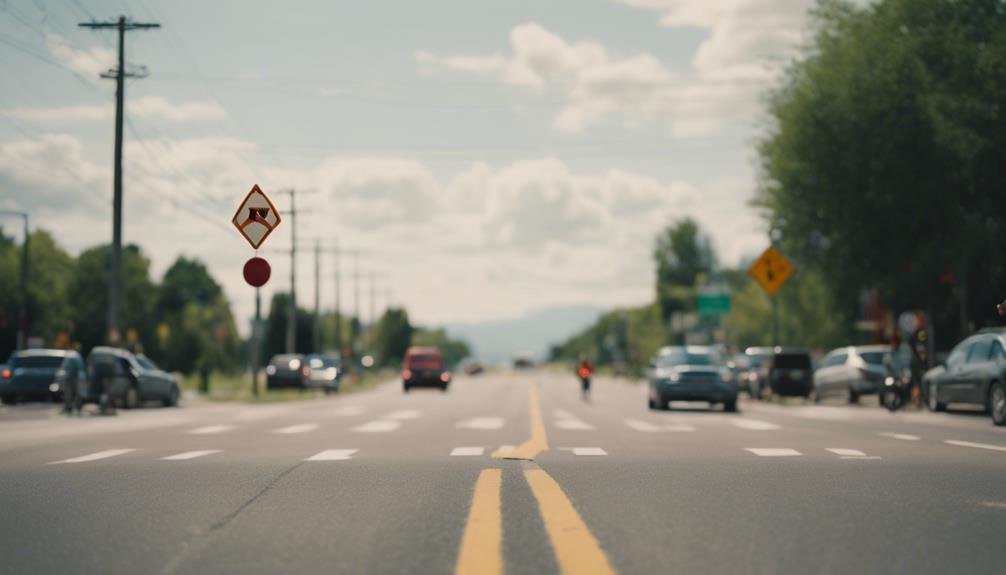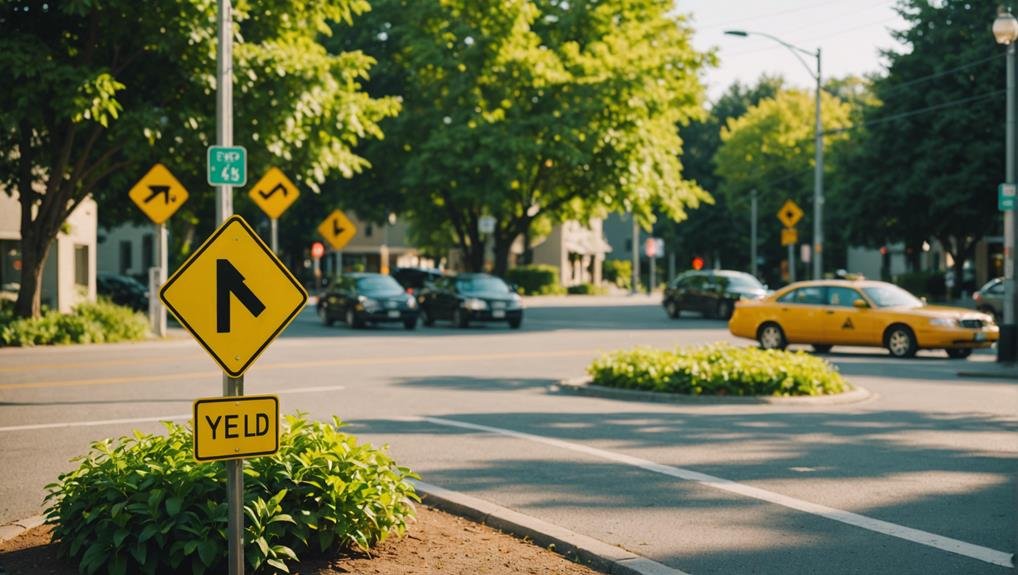As you navigate roads, understanding yield signs is essential for maintaining traffic safety. These regulatory signs indicate when you must give right-of-way to others, ensuring a smooth flow of traffic and preventing accidents. Strategically placed at intersections, yield signs regulate traffic flow, preventing collisions and promoting safe driving practices. Failure to comply can lead to accidents, injuries, or legal consequences. By recognizing the significance of yield signs, you'll better appreciate their role in maintaining traffic order and flow. Now, learn more about the history, placement, and rules surrounding yield signs, and how they impact road safety.
Key Takeaways
- Yield signs are regulatory signs that indicate giving right-of-way to others, ensuring a smooth flow of traffic and preventing accidents.
- Yield signs are strategically placed at intersections to regulate traffic flow, and failure to comply can lead to accidents, injuries, or legal consequences.
- Yielding ensures a smooth flow of traffic and prevents accidents by giving right-of-way to others, promoting safe driving practices.
- Obeying yield signs contributes to traffic order and flow, reducing accidents and near-misses at intersections.
- Failure to yield can result in fines, accidents, and legal liabilities, highlighting the importance of understanding and complying with yield signs.
Defining Yield Signs and Their Purpose
When you approach an intersection with a yield sign, you're being told to give right-of-way to others, and failure to do so can have serious consequences.
The yield sign, with its distinctive red and white triangular shape, is an important regulatory sign that plays a significant role in maintaining traffic safety. By yielding to other vehicles, pedestrians, or cyclists, you're ensuring a smooth flow of traffic and preventing accidents.
Yield signs are strategically placed at intersections to regulate the flow of traffic, allowing vehicles to merge safely and efficiently. It's important to understand that yield signs aren't suggestions, but rather mandatory instructions to give way to others.
Failure to comply can result in accidents, injuries, or even legal consequences. As you navigate through intersections, bear in mind that yield signs are in place to promote safety, and it's your responsibility to obey them.
History and Evolution of Yield Signs
As you've learned to navigate intersections with yield signs, you might wonder how this significant traffic regulation came to be, and its evolution over time is a fascinating story that begins in the United States in the mid-20th century.
In 1950, the initial yield signs appeared in Tulsa, Oklahoma, marking the commencement of a new period in traffic management. Over the years, the design and functionality of yield signs have undergone significant changes.
The unique equilateral triangle shape of the yield sign was standardized internationally in 1971, featuring a white triangle in a red frame without any words. Today, yield signs are typically posted at intersections where two roads merge or at the entrance to roundabouts, ensuring a smooth traffic flow.
The word 'Yield' on the sign signifies giving way or conceding to other vehicles or pedestrians. As you drive through intersections, keep in mind that yield signs have come a long way in shaping traffic regulations, and their evolution has played a pivotal role in maintaining order on our roads.
Yield Sign Placement and Regulations

Yield signs are strategically placed at intersections where two roads merge to regulate right-of-way and guarantee a smooth traffic flow. This placement guarantees that vehicles approaching the intersection must yield to other vehicles or pedestrians with the right-of-way, preventing potential collisions and promoting safe driving practices.
| Intersection Type | Yield Sign Placement |
|---|---|
| Two-way stop-controlled intersections | Yield sign is placed on the minor road |
| Intersections without stop signs | Yield sign is placed on the road with lower traffic volume |
| Intersections with pedestrian or cyclist traffic | Yield sign is placed near the crosswalk or bike lane |
As you navigate through roads, you must obey yield signs to prevent accidents and follow state traffic laws. Unlike stop signs, which require a complete stop, yield signs only require you to slow down and give way to other traffic. When you see a yield sign, you need to stop or slow down to let others pass, but you don't need to come to a complete stop unless necessary. By following yield signs, you contribute to maintaining order on the roads and ensuring a smooth flow of traffic.
Understanding Yield Sign Rules and Etiquette
You're expected to exercise caution and courtesy when approaching a yield sign, as it's important to prioritize the safety of other road users.
Yield signs, a type of regulatory sign, indicate that drivers must yield to vehicles or pedestrians with the right-of-way.
When approaching a yield sign, drivers must slow down and be prepared to stop, but they're not always required to come to a complete stop. Instead, they must yield to other traffic, pedestrians, or cyclists who have the right-of-way.
Yield signs play a significant role in regulating traffic flow at intersections without traffic lights, ensuring smooth and safe interactions between road users. By yielding to others, drivers help prevent accidents and minimize congestion.
Failure to yield can result in fines, legal consequences, or even accidents. As a responsible driver, it's important to understand and respect yield signs, recognizing their importance in maintaining traffic flow and ensuring safe interactions on the road.
The Impact of Yield Signs on Road Safety

By obeying yield signs, you greatly reduce the risk of accidents and near-misses at intersections, where the absence of traffic lights can otherwise lead to chaos. Yield signs play an important role in regulating right-of-way at intersections, promoting safe traffic merging and preventing potential accidents by indicating when drivers should give way to other vehicles.
By doing so, yield signs guarantee a smooth flow of vehicles at intersections, maintaining traffic flow efficiency. Failure to yield at a yield sign can result in fines, accidents, and potential legal liabilities, highlighting the importance of compliance with these regulatory signs. Yield signs are mandated by state laws and are crucial in preventing unnecessary risks and promoting road safety.
Frequently Asked Questions
What Is More Important a STOP Sign or Yield Sign?
You're wondering what's more significant, a stop sign or a yield sign? Honestly, it depends on the situation – stop signs require a full halt, while yield signs prioritize right-of-way, so both are vital in different contexts.
What Is the Difference Between a Red and Yellow Yield Sign?
You're wondering what distinguishes red and yellow yield signs? Fundamentally, red yield signs indicate mandatory stops on public roads, while yellow yield signs serve as cautionary warnings in non-standard traffic situations, like work zones or parking lots.
How to Go Through a Yield Sign?
When approaching a yield sign, you slow down, check for pedestrians and oncoming traffic, and be prepared to stop if necessary; then, proceed with caution, making sure it's safe to do so.
Does a Green Light Supersede a Yield Sign?
You're wondering if a green light trumps a yield sign? Nope, it doesn't. Even with a green light, you must yield to others with the right-of-way, as yield signs take priority over traffic lights.
Conclusion
As you've learned, understanding yield signs is essential for safe and responsible driving. By grasping the history, placement, and rules surrounding these signs, you'll become a more informed and defensive driver.
Yield signs play a critical role in maintaining road safety, and their importance can't be overstated. By following yield sign rules and etiquette, you'll greatly reduce your risk of accidents and help create a safer driving environment for everyone on the road.
